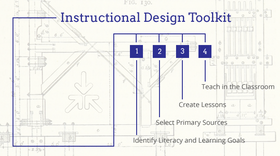Primary Source Exemplar: Human Rights, Conflict and Social Change
Reviewed and Revised by Odell Education
Unit Abstract
The lessons in this unit are designed for an ELA class. They are intended to be used, if possible, in a collaborative unit with a history teacher using the Universal Declaration of Human Rights.
Note: This lesson is intended to be taught in collaboration with a history teacher. Although it can stand alone as an ELA unit, if it is taught without the aid of a history teacher, the ELA teacher may need to supplement with additional texts to provide historical background and context for both the Universal Declaration of Human Rights and apartheid. Students' understanding of the history and context surrounding the texts will allow them to more deeply understand the significance of author’s craft in an analysis of related speeches.
Source List
Anchor Source
Universal Declaration of Human Rights
Supporting Sources
Excerpts from “Adoption of the Universal Declaration of Human Rights” by Eleanor Roosevelt
Nelson Mandela “Speech to the United Nations Special Committee against Apartheid”
The 30 Articles of the Universal Declaration of Human Rights
Standards Alignment
ELA/Literacy Grade Level Standards
RI.9-10.1 Through an examination of texts, students will learn to cite strong and thorough textual evidence to support analysis of what the text says explicitly as well as inferences drawn from the text
RI.9-10.2 Determine a central idea of a text and analyze its development over the course of the text, including how it is shaped and refined by specific details.
RI.9-10.3 Analyze how the author unfolds an analysis or series of ideas or events, including the order in which the points are made, how they are introduced and developed, and the connections that are drawn between them.
RI.9-10.4 Determine the meaning of words and phrases as they are used in a text, including figurative, connotative, and technical meanings, analyze the cumulative impact of specific word choices on meaning and tone
RI.9-10.6 Determine an author’s point of view or purpose in a text and analyze how an author uses rhetoric to advance that point of view or purpose
RI.9-10.8 Delineate and evaluate the argument and specific claims in a text, assessing whether the reasoning is valid and the evidence is relevant and sufficient
RI.9-10.9 Analyze seminal US documents of historical significance
L.9-10.4 Determine or clarify the meaning of unknown and multiple-meaning words and phrases based on grades 9 – 10 reading and content
SL.9-10.3 Evaluate a speaker’s point of view, reasoning, and use of evidence and rhetoric
W.9-10.1 Write arguments to support claims in an analysis of substantive topics or texts using valid reasoning and relevant and sufficient evidence
Direct Learning Through Questions
Essential Questions
- What are human rights?
- How do competing notions of human rights lead to conflict or change?
Text Based Questions
- How can written and/or spoken texts impact the fight for human rights?
- How do the choices authors make – especially regarding structure, rhetoric, and vocabulary – impact the tone, purpose, and influence of their texts?
Align Assessment with Instruction
Formative Assessment Strategies
Details within each lesson
Culminating/Summative Assessment Task
Details within each lesson
Consider Background Knowledge and Prerequisite Skills
Pre-Assessment of Readiness for Learning
Students should be able to demonstrate understanding of figurative language, word relationships, and nuances in meaning (L.9-10.5)
Students should know how to use context to determine vocabulary meaning and part of speech (L.9-10.4)
Students should be able to conduct short as well as more sustained research projects to answer a question (W.9-10.7)
Students should be able to gather relevant information from multiple authoritative print and digital sources, using advanced searches effectively; assess the usefulness of each source in answering the research questions; integrate information into the text selectively to maintain the flow of ideas, avoiding plagiarism and following a standard format for citation (W.9-10.8)
Students should know how to summarize and paraphrase.
Students should know how to annotate texts using a variety of strategies
Provide Support While Building Toward Independence
Strategies for Supporting All Students and Building Independence
Details within each lesson
Additional Suggestions for Support/Extension (Details within each lesson)
English language learners
Students with disabilities
Below grade level readers
Above grade-level readers
Lesson Guidelines: Lessons are structured differently, depending on the
particular pedagogical approach and instructional design preference of
the educator creating the lesson. For further guidance, refer to the Exemplar Lessons created by our Primary Source Working Group Educators.
